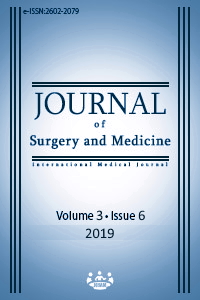Factors affecting mortality in Crimean-Congo hemorrhagic fever
Keywords:
Crimean–Congo hemorrhagic fever, Mortality, Emergency departmentAbstract
Aim: Crimean-Congo hemorrhagic fever is a viral disease that is transmitted by infected ticks and has high mortality. We aim to determine the factors affecting mortality in patients with Crimean–Congo hemorrhagic fever (CCHF).
Methods: Age, gender, number of ticks, tick removal procedures, tick location, time to hospital admission, symptoms, physical examination findings, vital signs, laboratory parameters and factors affecting mortality were evaluated. The study was designed as a retrospective cohort study.
Results: The median age of the 172 patients was 46 (range, 18–78) years, and 73.8% of the patients were men. The mortality rate was high in patients with delayed time to hospital admission, those who were bitten on the head and neck region, those who had a high number of tick bites, those who had removed the tick themselves or had the tick removed by a relative and those who had impaired consciousness (P=0.001, P<0.001, P<0.001, P<0.001 and P=0.002, respectively). Bleeding was detected in 87.2% of cases. The frequency of ecchymosis, pleural effusion, hematuria, hematemesis and melena occurrence was high in non-survivors (P<0.001, P<0.001, P<0.001, P=0.006 and P=0.006, respectively). Fever and heart rate were significantly higher, systolic and diastolic blood pressure was significantly lower in non-survivors (P<0.001, P<0.001, P=0.006 and P<0.001, respectively). Additionally, the white blood cell (WBC) count, international normalized ratio (INR), aspartate aminotransferase (AST) and alanine aminotransferase (ALT) levels were significantly higher and platelet count were significantly lower in non-survivors (P<0.001 for all).
Conclusion: We found that in patients with CCHF, bleeding was a major factor associated with mortality. Factors such as a number of ticks, the number of people removing the ticks and tick location were found to affect mortality. We believe that blood tests and vital parameters can be used to predict mortality in patients with CCHF.
Downloads
References
Ahmeti S, Berisha L, Halili B, Ahmeti F, von Possel R, Thome-Bolduan C, et al. Crimean-Congo Hemorrhagic Fever, Kosovo, 2013-2016. Emerg Infect Dis. 2019;25(2):321–24. doi:10.3201/eid2502.171999.
Appannanavar SB, Mishra B. An update on crimean congo hemorrhagic Fever. J Glob Infect Dis. 2011;3 (3):285-92. doi:10.4103/0974-777X.83537.
Karakecili F, Cikman A, Aydin M, Binay UD, Kesik OA, Ozcicek F. Evaluation of epidemiological, clinical, and laboratory characteristics and mortality rate of patients with Crimean-Congo hemorrhagic fever in the northeast region of Turkey. J Vector Borne Dis. 2018;55 (3):215-21. doi: 10.4103/0972-9062.249479.
Karlberg H, Tan YJ, Mirazimi A. Induction of caspase activation and cleavage of the viral nucleocapsid protein in different cell types during Crimean-Congo hemorrhagic fever virus infection. J Biol Chem. 2011;286(5):3227-34. doi:10.1074/jbc.M110.149369.
Spengler JR, Bergeron E, Spiropoulou CF. Crimean-Congo hemorrhagic fever and expansion from endemic regions. Curr Opin Virol. 2019;34:70-8. doi: 10.1016/j.coviro.2018.12.002.
Bente DA, Forrester NL, Watts DM, McAuley AJ, Whitehouse CA, Bray M. Crimean-Congo hemorrhagic fever: history, epidemiology, pathogenesis, clinical syndrome and genetic diversity. Antiviral Res. 2013;100(1):159-89. doi: 10.1016/j.antiviral.2013.07.006.
Hasanoglu I, Guner R, Carhan A, Kocak Tufan Z, Yagci-Caglayik D, Guven T, et al. Crucial parameter of the outcome in Crimean Congo hemorrhagic fever: Viral load. J Clin Virol. 2016;75:42-6. doi: 10.1016/j.jcv.2015.12.006.
Franz DR, Jahrling PB, Friedlander AM, McClain DJ, Hoover DL, Byrne WR, et al. Clinical recognition and management of patients exposed to biological warfare agents. Jama. 1997;278(5):399-411.
Saksida A, Duh D, Wraber B, Dedushaj I, Ahmeti S, Avsic-Zupanc T. Interacting roles of immune mechanisms and viral load in the pathogenesis of crimean-congo hemorrhagic fever. Clin Vaccine Immunol. 2010;17(7):1086-93. doi: 10.1128/CVI.00530-09.
Yilmaz GR, Buzgan T, Irmak H, Safran A, Uzun R, Cevik MA, et al. The epidemiology of Crimean-Congo hemorrhagic fever in Turkey, 2002-2007. Int J Infect Dis. 2009;13(3):380-6. doi: 10.1016/j.ijid.2008.07.021.
Uluğ M. Kene Isırması Nedeniyle Başvuran Olguların Epidemiyolojik, Klinik ve Laboratuvar Bulgularının İrdelenmesi. Klimik Dergisi. 2011;24(1):40-3. doi: 10.5152/kd.2011.08.
Gök ŞE. Kırım-Kongo Kanamalı Ateşi. Okmeydanı Tıp Dergisi 2016;32:13-9. doi: 10.5222/otd.2016.013.
Sümer A. Kene Isırığı Nedeniyle Kaş Devlet Hastanesi Acil Servisine Başvuran Hastaların Değerlendirilmesi. Kafkas Univ Vet Fak Derg.2010;16:49-53. doi: 10.9775/kvfd.2009.378.
Hussain Q, Shaikh BH, Bhutto AR, Sohaib M. An Unusual Case of Crimean Congo Hemorrhagic Fever: Prolonged Bleeding with Successful Recovery. J Coll Physicians Surg Pak. 2016;26 (2):151-3. doi: 02.2016/JCPSP.151153.
Kleib AS, Salihy SM, Ghaber SM, Sidiel BW, Sidiya KC, Bettar ES. Crimean-Congo Hemorrhagic Fever with Acute Subdural Hematoma, Mauritania, 2012. Emerg Infect Dis. 2016;22(7):1305-6. doi: 10.3201/eid2207.151782.
Bartolini B, Gruber CE, Koopmans M, Avšič T, Bino S, Christova I, et al. Laboratory management of Crimean-Congo haemorrhagic fever virus infections: perspectives from two European networks. Euro Surveill. 2019;24(5). doi: 10.2807/1560-7917.ES.2019.24.5.1800093.
Swanepoel R, Gill DE, Shepherd AJ, Leman PA, Mynhardt JH, Harvey S. The clinical pathology of Crimean-Congo hemorrhagic fever. Rev Infect Dis. 1989;11(4):794-800.
Downloads
- 1672 2258
Published
Issue
Section
How to Cite
License
Copyright (c) 2019 Nezih Kavak, Yunus Gürbüz
This work is licensed under a Creative Commons Attribution-NonCommercial-NoDerivatives 4.0 International License.
















